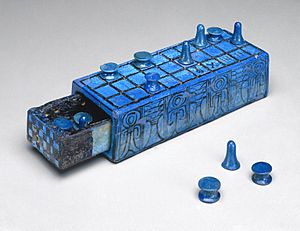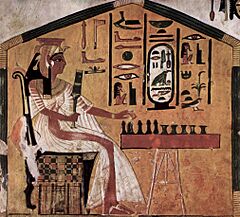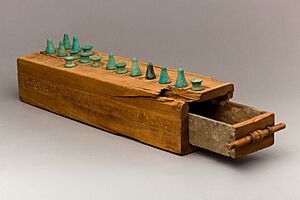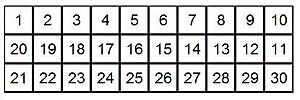Senet facts for kids

A Senet game set that belonged to Amenhotep III (around 1391–1353 BCE)
|
|
| Genre(s) | Board game |
|---|---|
| Players | 2 |
Senet (pronounced "seh-net") is a super old board game from ancient Egypt. It has a board with 30 squares and uses ten or more playing pieces.
The first time we see Senet is around 2620 BCE. It was found in a tomb called the Mastaba of Hesy-Re. But similar boards and symbols have been found even earlier! Even though people played this game for over 2,000 years in Egypt, the boards and pieces didn't change much. We know this because archaeologists have found many Senet boards. We also see pictures of people playing Senet on tomb walls and old papyrus scrolls.
Sadly, people stopped playing Senet after the Roman period. So, we don't know the exact rules of the game today.
Contents
Discovering Senet Through Time
| Senet in hieroglyphs | ||||
|---|---|---|---|---|
znt ("passing") |
||||
| A painting in the tomb of Queen Nefertari (1295–1255 BCE) showing Senet | ||||
Some broken pieces of what might be Senet boards were found in very old Egyptian tombs. These date back to around 3100 BCE. The first clear picture of someone playing Senet is from a tomb around 2686–2613 BCE. This tomb belonged to a high official named Hesy.
Later, in the Fifth Dynasty (around 2500 BCE), more pictures of Senet appeared. People like the vizier Rashepses were shown playing. Even famous people like Tutankhamun and Nefertari (the wife of Ramesses II) are shown playing Senet in tomb art from the New Kingdom.
Senet also shows up in ancient writings. In Chapter 17 of the Book of the Dead, a person who has died plays the game against an unseen opponent. There's also a cool picture on a papyrus scroll from around 1250–1150 BCE. It shows a lion and a gazelle playing Senet! You can see this papyrus at the British Museum.
A story from the Roman period, called Setne Khamwas and Si-Osire, also talks about a board game. In this tale, a character named Naneferkaptah challenges Setne to a game. The winner gets a special book. The story doesn't say it's Senet, but the game's religious meaning and how it's set up make many think it was Senet.
Senet Boards Found by Archaeologists
The oldest complete Senet boards we have are from the Middle Kingdom. But drawings of Senet on old monuments might be even older. However, no actual Senet boards from the Fourth to Sixth Dynasties have been found, only pictures of them.
One Senet board at the Rosicrucian Egyptian Museum shows how the game changed. It started as a regular game but became more religious over time. This board is from the early New Kingdom of Egypt.
Senet Outside Egypt
Some historians think Senet might have started in the Levant (an area near Egypt) before Egypt. But because Egypt had a lot of influence there, Egyptians might have brought the game. Senet was also played in Cyprus around 3000 BCE and continued for a long time.
Even though some historians believe Senet disappeared after the Romans, there's some evidence it was still around. You can find Senet drawings on the roof of the Roman Temple of Dendera. This shows the game was still known during the Roman period.
How Senet Was Played
Since people stopped playing Senet a long time ago, we don't know the exact rules.
Senet boards were usually made from wood, ivory, or a shiny material called faience. The board had a grid of 30 squares, arranged in three rows of ten. A full Senet game set would have special pieces for each of the two players. By the New Kingdom, these pieces often looked like hounds or dog-headed figures.
For most of its history, the Senet boards themselves showed the direction of play. This usually started from the top left corner. The last five squares on the board were often the most decorated. These special decorations usually had symbols related to good luck or water.
By the New Kingdom (1550–1077 BCE), the game had a deeper meaning. It was thought to represent the journey of the ka (a part of the soul) through the duat (the underworld). The squares on the board represented different stages of this journey. This idea is explained in ancient texts and shown by the religious symbols on the boards.
See also
- Khaemweset – a son of Ramses II, who inspired the fictional Setne character
- Hounds and Jackals – another ancient Egyptian board game
- Mehen – another ancient Egyptian game
- Royal Game of Ur – a game from Mesopotamia played around 3000 BCE
- Tâb – a Middle Eastern game sometimes confused with Senet




